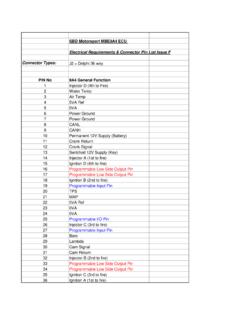Transcription of / TECH / BEFORE STARTING… UNDER PRESSURE
1 UNDER PRESSUREW ords: Stewart Sanderson0110 AUGUST 2006 FAST FORD 0111 FAST FORD AUGUST 2006fasttechUNDER PRESSURE fasttech/ TECH / FUEL PRESSURE /The fi rst rule of working on cars and using tools of any kind is don t ever skimp on decent protection. Goggles, gloves, ear defenders, masks and a set of overalls should be in your garage. Use them. When using power tools, protective gear is essential grinders and welders can make a real mess of your soft skin and bone if you get it wrong. Never work UNDER a car without supporting it using axle stands. A car falling on you is not something you ll be laughing about down the my day-to-day work as a tuner, one of the things I often find myself doing is adjusting people s fuel PRESSURE back to , given the fact that all standard fuel regulators that I can think of are tamper-proof in one way or another to avoid DIY adjustment, why on earth do they always seem to be untamper-proofed when they get to me?
2 Worst of all they are always set too high, very rarely too seems to me that the answer can only be that people can t help but mess with things they don t fully understand. The term A little knowledge is dangerous can easily be applied to fuel PRESSURE . All too often I hear the excuse, I just turned it up for a bit of extra fuel , not to mention the old chestnut, More fuel PRESSURE gives it more power doesn t it? . Then I end up spending the next half-an-hour explaining why that is absolute garbage, and how you are almost as likely to end up with a melted piston by running too much PRESSURE as you are with too little not to mention you are more likely to have a meltdown with excess PRESSURE in some systems than if you simply ran the correct PRESSURE (presuming air-fuel ratio (AFR) is correct at standard PRESSURE , of course).So, why is it possible to melt an engine with excess fuel PRESSURE ?
3 Surely, too much fuel is far safer than too little? Well, the additional If the dyno operator tells you you re engine s running lean at full boost, don t just turn the fuel PRESSURE up. Here s rapidly from a few friends contributing, to one of the biggest Ford communities on the s enviable knowledge of the workings of modern-day Ford WHO IS STU?Having worked as a tuner for over 16 years, Stewart Stu Sanderson is one of the most respected names in the Level 5-trained fuel-injection technician, in the past Ford nut Stu s worked for a Ford RS dealer, a well-known fuel-injection specialist and various tuning companies. Then six years ago, he joined forces with Kenny Walker and opened up Motorsport Developments near Blackpool, specialising in engine management live remapping, as well as developing a range of Evolution chips which are now sold all over the s also jointly responsible with Webmaster, Petrucci for Started in 2003, it s performance engines means that he s just the man to explain how and why things work, and most importantly, how they can be improved!
4 PRESSURE brings about its own pitfalls, so let s go back to basics and see if I can explain it using some easy to understand terminology. PLUMBINGHow are fuel injection systems plumbed in? The most basic fuel injection systems will have an electric fuel pump, connected via high PRESSURE fuel lines (pipes) to a fuel rail that in turn houses the fuel injectors that deliver the fuel to the the end of this fuel rail will normally be a fuel PRESSURE regulator. The regulator, as its name suggests, regulates the PRESSURE seen in the pipe and fuel rail. The fuel pump fi res out fuel at a maximum rate of approx 9 bar into the fuel line and the fuel regulator depending on its settings will drop this PRESSURE down to the desired running PRESSURE by simply controlling the amount of fuel allowed to leave the pipe and fl ow back to the fuel tank via the fuel return lines. So, for a system such as the Sierra Cosworth, we start at 9 bar and then the regulator opens up as it reaches bar and leaks fuel back to the tank in a controlled manner, thus achieving a regulated bar of fuel PRESSURE at the injectors.
5 This is the correct setting for this system with most commonly-used fuel injectors. Simple you think? Yes it is simple, at least until the engine actually starts PRESSUREWhy do we actually need to be UNDER such high PRESSURE ? OK, that s a good question, and the answer lies at the all important fuel injectors. The fuel injectors on most EFi systems are simply solenoid valves that are capable of both handling fuel in a harsh unforgiving environment and operating very quickly and reliably typically as fast as is simple; the injector takes the fuel in at the top (or sometimes from the side) and then UNDER command from the ECU, opens for as long as it is told to and injects the fuel. The fuel is required to come out of the nozzle in a particular spray pattern and be atomised to a certain level so as to ensure correct mixture into the air stream. This atomisation level and spray pattern is chosen by the engine designers, and they then choose an injector to suit their requirements.
6 The injector Fuel injectors are simply valves controlled by the ECUE lectric fuel pumps can fi re out fuel at a massive 9 FORD AUGUST 2006chosen dictates the fuel PRESSURE required and the system is designed from here upwards. Most commonly, these pressures are in the 3-4 bar does the regulator just regulate to a set PRESSURE and that s it? No. And this is where people start to fall over and make silly and often costly mistakes. You will notice that most fuel PRESSURE regulators have a small pipe on the top that is connected to the plenum (or somewhere similar) where it can sense manifold absolute PRESSURE (MAP). This pipe has the incredibly important job of carrying a vacuum or PRESSURE signal to the spring and diaphragm assembly that is assembled within the THE SIGNALWhy does the regulator need this signal? What does it do with it? This is where the regulator becomes more complex.
7 It is deemed necessary to run a different PRESSURE depending on the depression or PRESSURE within the inlet tract itself. The reason for this is to keep fuel fl ow linear regardless of vacuum or boost PRESSURE . Please allow me to elaborate in the most simple of layman s s imagine that your lungs are the fuel pump, the water in your mouth is the fuel, and a straw in your mouth is the fuel line and injector. A glass on the table can be our engine s cylinder. You have a Fuel PRESSURE regulator is the pork pie hat-shaped canister halfway up the left-hand side of this pic. The top pipe connects to the plenum chamber and relays a PRESSURE signal back to the spring and diaphragm inside the regulator to determine the fuel PRESSURE suppliedInside the Cosworth YB plenum (top pic) you ll fi nd these four inlets. It s the air PRESSURE going into these that the fuel regulator needs to monitor BEFORE it can distribute fuel at high PRESSURE into those four holes on the inlet manifold via the injectorsfasttechmouth full of water, and you wish to empty that water, into the glass, using the straw in your let s imagine we have measured your lung capacity and know it to be exactly 2 psi, so you blow the water out into the glass and it takes you 10 seconds to do so.
8 With no resistance at the end of the straw you blew the water out very easily, as you would expect. Now try and imagine that exercise mimicked a fuel injector that was injecting fuel into the cylinder of an engine that was turned off. No real fasttechfasttech/ TECH / FUEL PRESSURE /If the air-fuel ratio starts to lean out a high rpm on a power run, it could be down to a number of elements (too much boost, restricted fuel lines etc) not just insuffi cient fuel pressuredifference between a cylinder and your glass in that scenario (other than the injector being at a higher PRESSURE ).Now, what would happen if you tried the same exercise again, but this time someone was sucking at the end of your straw very hard? You would be right in thinking you would empty your mouth full of water faster than 10 seconds. Why? Because your 2 psi PRESSURE now has something at the other end helping it to travel through the pipe, effectively increasing the transfer rate of the fl uid through the straw (injector).
9 Let s imagine then, that scenario was the fuel injector fi ring fuel into an engine that is idling. (We presumably all know that petrol engines with a closed or low throttle generate a partial vacuum in the plenum don t we? That s how the air is sucked in to be mixed with the fuel.)Now for an interesting scenario. Let s imagine the same job is to be done, with your straw and mouthful of water, but this time we are going to put an equal PRESSURE at the other end of your straw. So you are blowing water down the straw with 2 psi of lung PRESSURE , but you now have 2 psi at the other end of your straw pushing back at you, so what happens now? Well, nothing at all, it s a stalemate. The differential PRESSURE is nil so we have no fl ow. What you have just learnt is the effects of a PRESSURE differential on fl uid fl ow, and that s where the little pipe comes LITTLE PIPE?What effectively happens when the engine is running is this:The fuel PRESSURE is set in this example, to bar at atmosphere.
10 That s with the signal pipe disconnected. When we connect the pipe, it acts on a diaphragm and spring and affects the fuel PRESSURE with a ratio of 1:1. This means that for every 1 psi of difference the plenum has to atmosphere, the fuel PRESSURE will be adjusted accordingly by 1 psi. For example, if we have 1 bar of PRESSURE at the pipe (1 bar of turbo boost), we will run our bar plus 1 bar of additional PRESSURE . This has the effect of ensuring the fuel PRESSURE at the nozzle is always exactly bar above whatever PRESSURE is measured within the inlet tract, so the fuel fl ow is always constant and of a known entity, unlike the fl ow we had through the straw once we equalised the PRESSURE . Just think what would have happened if we had applied 8 psi to the other end of your , in a nutshell, we need to keep the fuel PRESSURE a set amount above whatever PRESSURE is seen in the plenum at the injector pintle.






